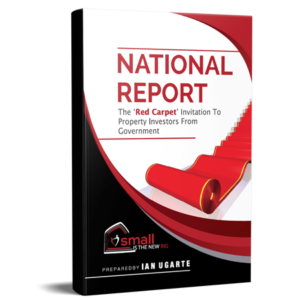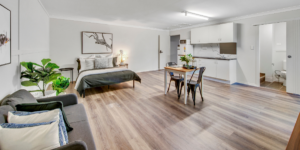When you build an adaptable house, you open it up to everyone in the marketplace, instead of just one group.
By adaptable, I mean building a rental property investment specifically so it can be configured different ways to accommodate different renter segments. That widens the potential funnel of people who might share the home with you down the track, or rent part or all of it.
As opposed to building a regular family home (which gives you more of a parallel line than a funnel).
SCROLL DOWN for the 7 rental demographics adaptable homes attract.

1. Family home – You build the property from scratch, then you might live in it for a number of years, possibly starting and/or growing your family there. Because you’ve done the smart thing and gained legal approval through the council or a private certifier from the outset, you’ll be able to rent out parts of the house to others down the track (see below). That helps you pay off your mortgage quickly.
2. Family home, renting out secondary dwelling – This is the house-and-granny-flat scenario. Perhaps you’ve had two or three kids and your family is filling up the main house, and you have someone in the granny flat helping pay the mortgage.

3. Multi-generational family – At some point, you might decide to bring in mum and dad who are ageing and not able to look after their own place anymore, but don’t want to move into a nursing home. (Or for that matter, mum and dad could move in earlier when they’re still sprightly – built in babysitters.)
Or later, when your kids are adults and they’re facing up to housing ‘unaffordability’, they might move back in, maybe with a spouse, maybe with young kids, while they’re saving for their own place.
Find out how you can invest in an adaptable, co-living investment property with INVIDA, HERE.

4. Siblings and friends – What if you’re still living in the house, and you get to an age where you want to go off for a few years and travel say, or want to buy a smaller place? Then your kids might move in and share the house. Or invite their boyfriends/girlfriends/friends in to pay rent. Then you end up with four, five, even six people living in the house. It becomes an informal kind of share house where related parties live together.
5. Co-living share house – In my book, a house is only truly adaptable if it enables co-living. This is the formal kind of share house, where the residents don’t know each other and each signs a separate agreement with their landlord. Because the house has been built to meet co-living standards and signed off for higher usage, it already has the requisite private spaces, shared spaces, locks on bedrooms doors, etc.
Read some first hand accounts from happy co-living residents HERE.

6. NDIS/disability housing – If the house is purpose built for co-living, you already have disability access in place (NDIS/SDA silver level) because it’s a mandatory step in getting co-living approval. Hence, you open up to people with disability and meet a community need.
7. Uplifers – Some people say downsizers, but I coined “uplifers” because in this phase of life, you’re enjoying life, ageing in place while you rent out parts of your house, with your caravan parked in the driveway. Every three months you go away in the van while the rent is still coming in.
No need to worry about moving to a retirement village, finding a new shopping centre, finding the parks you like, navigating new neighbours – because you don’t have to move.

I always say if you’re going to build a house, you should be future proofing it for the next 50 years. That means you never have to move out of it if you don’t want to, because it adapts to every stage in your cycle of life.
If you build it as a rental investment, with these seven demographics in mind, your investment will never, ever be empty.
Creating as many positive outcomes as possible
Another way of looking at adaptability is this: if you’re going to build a new home as an investment property, then you should view it as creating outcomes – for everyone.
Outcomes for you, because you can rent part of it to pay your mortgage down. Or if you rent the whole thing out as a co-living property, your outcome is an incredibly high rental yield.
There are outcomes for a multi-generational family, having three generations living and growing together. Outcomes for someone with a disability because disability standards are inbuilt to the property. Outcomes for the uplifers who have an income stream, and outcomes for friends or siblings who can live together, affordably, in a social environment.
Everyone has a beneficial outcome when you start designing a house in the way it should be designed.
JOIN MY UPCOMING WEBINAR to learn more about how INVIDA co-living cash flow positive properties can get you to your financial goals sooner! Register HERE.







